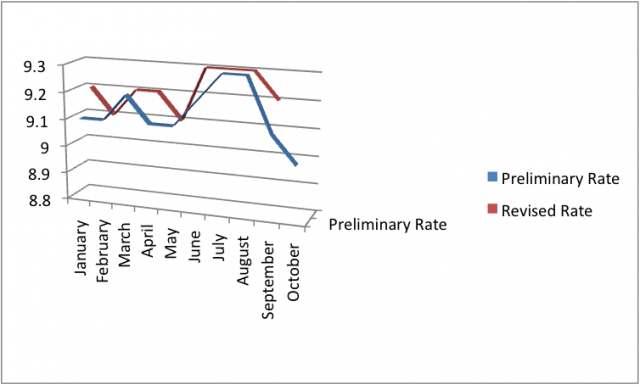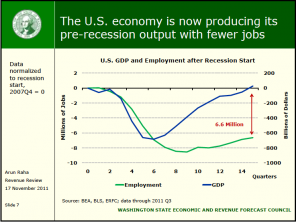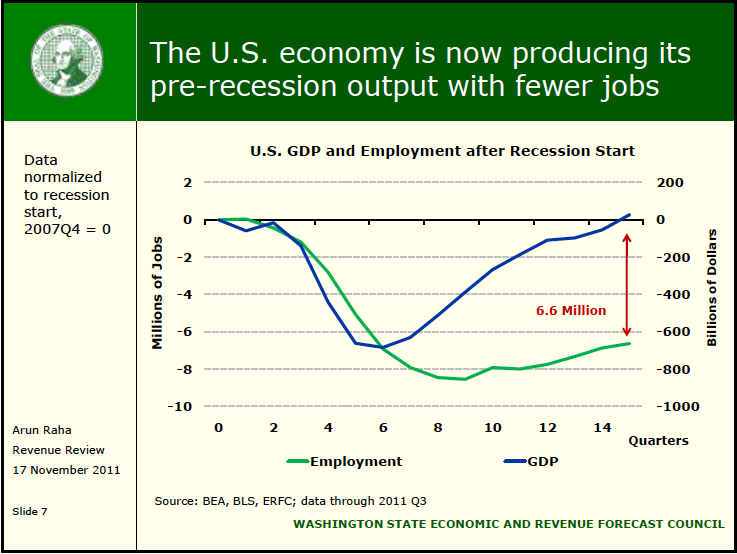
Here’s a riddle for you. Washington State’s unemployment rate is tracked to the tenth of a percentage point (though whether the data supports that level of precision is arguable). It has “fallen” for seven out of ten months in 2011, yet in January the (preliminary) rate was 9.1 percent and in October it was 9.0. Is this a new instance of Zeno’s Paradox?
Most recently, it fell in the Seattle Times, Seattlepi.com, and Puget Sound Business Journal. (In fairness, “dipped slightly” in the Times.) Still, common sense tells you that somehow you are not getting the whole picture from the headlines. Nothing can fall that often, without going up, and yet remain within a tenth of percentage point of its beginning. The long-term picture is of an economy that, while not declining, is failing to gain ground in hiring.
I hesitate to call it a conspiracy so much as dogged optimism, but what you almost never read in the headline is “Revised Rate Adjusted Upward for Seventh Time”–I don’t actually recall that ever being in the headline, honestly, but to be on the safe side, I’ll add that “almost never.” But that’s how it works. The lagging revised rate corrects the preliminary rate upward, and then the succeeding month’s rate can be said to have “fallen,” even if, comparing preliminary rate to preliminary rate, you have exactly the same number, month to month.
This matters because on nights when Occupy Seattle blocks bridges with the aid of union members, as a protest against job losses, some fuming in their cars may be questioning whether things are that bad. Surely, after seven months of falling unemployment, things are getting better? And such complacency is best avoided, whether you think snarling commutes is ultimately helpful or not. So far this year, the state has lost 8,800 public sector jobs (5,400 being state workers).
In October alone, “Professional and business services lost an estimated 7,000 jobs over the month, more than any other sector. The transportation, warehousing and utilities sector lost an estimated 1,100 jobs and the retail sector lost an estimated 1,000 jobs,” says the ESD.
It’s not all gloom and doom. Delightfully, in fall, the state also sees a seasonal bump in what it calls “apple employment,” this year up 8.7 percent. And as the state’s chief economist Arun Raha notes in his November update to Washington’s revenue forecast:
We expect Washington’s economy to outperform the U.S. in the recovery. Boeing and Microsoft are both hiring again. The aerospace sector has added 9,100 jobs since May 2010, which is 3,100 more than the number lost during the recession, while the software sector has added 1,900 jobs since December 2009, making up for most of the 2,500 jobs lost during the recession. The state’s farming and export sectors are also doing well. Washington exports were up 29% in the third quarter of this year compared to the previous year.
Boeing’s commercial airplane division has just leased 45,000 square feet of space in downtown Seattle’s Russell Investments Center. These are the kinds of developments that have stanched the bleeding of job loss.
 When Raha surveys the national scene, he sees this stagnant hiring situation writ large. You may be surprised to hear that the U.S.’s real gross domestic product is “back up to its pre-recession peak,” but that the nation has managed to do this with 6.8 million fewer jobs.
When Raha surveys the national scene, he sees this stagnant hiring situation writ large. You may be surprised to hear that the U.S.’s real gross domestic product is “back up to its pre-recession peak,” but that the nation has managed to do this with 6.8 million fewer jobs.
Growth in jobs has been excruciatingly slow in this recovery. The economy added just 80,000 net new jobs in October, although the previous two months were revised up a combined 102,000. Cutbacks in the public sector continue to weigh down the employment recovery with cuts of 24,000 across all levels of government. Almost 14 million people remained unemployed.
And cutbacks in government seem assured. In a good-news-bad-news sandwich, Raha announced that general fund revenue for the 2009-11 biennium should come to $28.2 billion, $25 million higher than previously estimated, but that his forecast for the 2011-13 biennium is $30.2 billion, $122 million lower. Meanwhile, Governor Gregoire has warned the Legislature to be prepared for a “brutal” November special session “that could include even deeper cuts to state education spending,” as KING TV reported.
Hiring in education was one of the bright spots in this year’s jobs reports. As the state looks to cut another $2 billion, that seems unlikely to repeat itself. (At current spending/revenue levels, the state faces a deficit of nearly $1.4 billion through 2013.)
At long last, we may need to break through the no-new-revenues deadlock. The budget policy group behind Budget Schmudget argues that cutting education spending threatens economic growth, and advises a new capital gains tax. At a Seattle Transit Blog meetup, WSDOT’s Paula Hammond said that the gas tax “has lost 49% of its purchasing power over the last ten years since the tax isn’t tied to inflation.”


